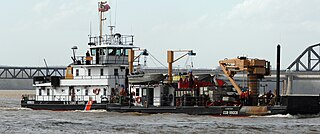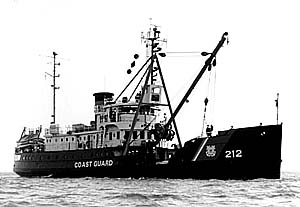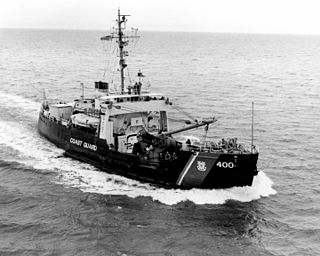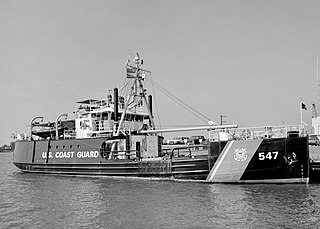Tender history
White Alder was stationed at New Orleans, Louisiana throughout her Coast Guard career, which spanned 1947 until 1968. Her primary assignment was to tend river aids-to-navigation although she was called upon to conduct other traditional Coast Guard duties, such as search and rescue or law enforcement duties, as required. In mid-November 1965 she escorted raised barge carrying chlorine to a chemical plant and on 4 December 1968 she refloated cutter USCGC Loganberry (WLI-65305), which had been beached on 3 December.
At approximately 18:29 CST on 7 December 1968, the "downbound" White Alder collided with the "upbound" M/V Helena, a 455-foot (139 m) Taiwanese freighter in the Mississippi River at mile 195.3 above Head of Passes near White Castle, Louisiana and sank in 75 feet (23 m) of water. Three of the crew of 20 were rescued, while the other 17 perished. Divers recovered the bodies of three of the dead but river sediment buried the cutter so quickly that continued recovery and salvage operations proved impractical. The Coast Guard decided to leave the remaining 14 crewmen entombed in the sunken cutter, which remains buried in the bottom of the Mississippi River.
The Coast Guard dedicated a memorial, at the Coast Guard base in New Orleans, to the White Alder and her crew on 7 December 1969. The memorial was moved to the new Coast Guard Group New Orleans offices in Metairie, Louisiana, and rededicated on 6 December 2002.

The USCG seagoing buoy tender is a type of United States Coast Guard Cutter used to service aids to navigation throughout the waters of the United States and wherever American shipping interests require. The U.S. Coast Guard has maintained a fleet of seagoing buoy tenders dating back to its origins in the U.S. Lighthouse Service (USLHS). These ships originally were designated with the hull classification symbol WAGL, but in 1965 the designation was changed to WLB, which is still used today.

USCGC Sundew (WLB-404) was a 180-foot (55 m) sea going buoy tender (WLB). An Iris, or C-class tender, it was built by Marine Iron and Shipbuilding Corporation in Duluth, Minnesota, United States. Sundew's preliminary design was completed by the United States Lighthouse Service and the final design was produced by Marine Iron and Shipbuilding Corporation in Duluth for the U.S. Coast Guard. On 29 November 1943 the keel was laid. It was launched on 8 February 1944 and commissioned on 24 August 1944. The original cost for the hull and machinery was $861,589.

USCGC Alder (WLB-216) is the final Juniper-class, 225-foot (69 m) seagoing buoy tender of the United States Coast Guard.

The United States Coast Guard commissioned a new Keeper class of coastal buoy tenders in the 1990s that are 175 feet in length and named after lighthouse keepers.

United States Coast Guard Cutter is the term used by the U.S. Coast Guard for its commissioned vessels. They are 65 feet (19.8 m) or greater in length and have a permanently assigned crew with accommodations aboard. They carry the ship prefix USCGC.

A buoy tender is a type of vessel used to maintain and replace navigational buoys. This term can also apply to an actual person who does this work.

USCGC Juniper (WLB-201) is the lead ship of the U.S. Coast Guard's current class of seagoing buoy tenders. She is outfitted with some of the most advanced technological and navigational capabilities currently available.

The United States Coast Guard Cutter Fir was the last lighthouse tender built specifically for the United States Lighthouse Service to resupply lighthouses and lightships, and to service buoys. Fir was built by the Moore Drydock Company in Oakland, California in 1939. On 22 March 1939, the U.S. Lighthouse Tender Fir was launched. She was steam driven with twin screws, 175 feet (53 m) in length, had a beam of 32 feet (9.8 m), drew 11 feet 3 inches (3.43 m) of water, and displaced 885 tons. Fir was fitted with a reinforced bow and stern, and an ice-belt at her water-line for icebreaking. She was built with classic lines and her spaces were lavishly appointed with mahogany, teak, and brass. The crew did intricate ropework throughout the ship. The cost to build Fir was approximately US$390,000. Fir's homeport was Seattle, Washington for all but one of her fifty one years of service when she was temporarily assigned to Long Beach, California when USCGC Walnut was decommissioned on 1 July 1982.

USCGC Fir (WLB-213) is a Juniper-class cutter of the United States Coast Guard. USCGC Fir is under the Operational Control (OPCON) of the Commander of the Thirteenth Coast Guard District and is homeported in Astoria, Oregon. Fir's primary area of responsibility is the coastal waters, river bars and high seas of the Washingtonian and Oregonian coasts. USCGC Fir conducts heavy lift aids to navigation operations, law enforcement and other missions as directed.
USCGC Tupelo WAGL/WLB-303, was a Cactus (A) Class 180-foot buoy tender vessel built by Zenith Dredge Company of Duluth, Minnesota. Her keel was laid 15 August 1942, launched 28 November 1942 and commissioned on 30 August 1943. She was built as a WAGL and redesignated a WLB in 1965.

USCGC Kukui (WLB-203) is the third cutter in the Juniper-class 225 ft (69 m) of seagoing buoy tenders and is the third ship to bear the name. She is under the operational control of the Commander of the Seventeenth Coast Guard District and is home-ported in Sitka, Alaska. Her primary area of responsibility is the inland and coastal waters of southeastern Alaska. Kukui conducts heavy lift aids-to-navigation operations, and law enforcement, homeland security, environmental pollution response, and search and rescue as directed.

USCGC Salvia (WLB-400) was a United States Coast Guard Iris-class buoy tender in commission from 1944 to 1991. She operated in the Great Lakes and along the United States Gulf Coast during her career. Sold and renamed Brian Davis in 2020 for use as a memorial vessel, she was scuttled as an artificial reef in 2020.

USCGC Ida Lewis (WLM-551) is the lead ship of the United States Coast Guard Keeper-class of Coastal Buoy Tenders. Launched in 1995, she has spent her entire career maintaining navigational aids near her homeport of Newport, Rhode Island.

USS YF-339 was an American YF-257-class covered lighter built in 1944 for service in World War II. She was later acquired by the United States Coast Guard and renamed USCGC White Bush (WAGL-542).

USS YF-444 was an American YF-257-class covered lighter built in 1944 for service in World War II. She was later acquired by the United States Coast Guard and renamed USCGC White Sage (WAGL-544).

USS YF-416 was an American YF-257-class covered lighter built in 1943 for service in World War II. She was later acquired by the United States Coast Guard and renamed USCGC White Sumac (WAGL-540).

USS YF-448 was an American YF-257-class covered lighter built in 1943 for service in World War II. She was later acquired by the United States Coast Guard and renamed USCGC White Pine (WAGL-547).

USS YF-446 was an American YF-257-class covered lighter built in 1943 for service in World War II. She was later acquired by the United States Coast Guard and renamed USCGC White Lupine (WAGL-546).

USS YF-445 was an American YF-257-class covered lighter built in 1943 for service in World War II. She was later acquired by the United States Coast Guard and renamed USCGC White Heath (WAGL-545).

The White-class buoy tender is a class of buoy tenders of the United States Coast Guard. Eight ships of the YF-257-class lighter were transferred from the United States Navy and were in commission from 1947 until 2002.
This page is based on this
Wikipedia article Text is available under the
CC BY-SA 4.0 license; additional terms may apply.
Images, videos and audio are available under their respective licenses.


















